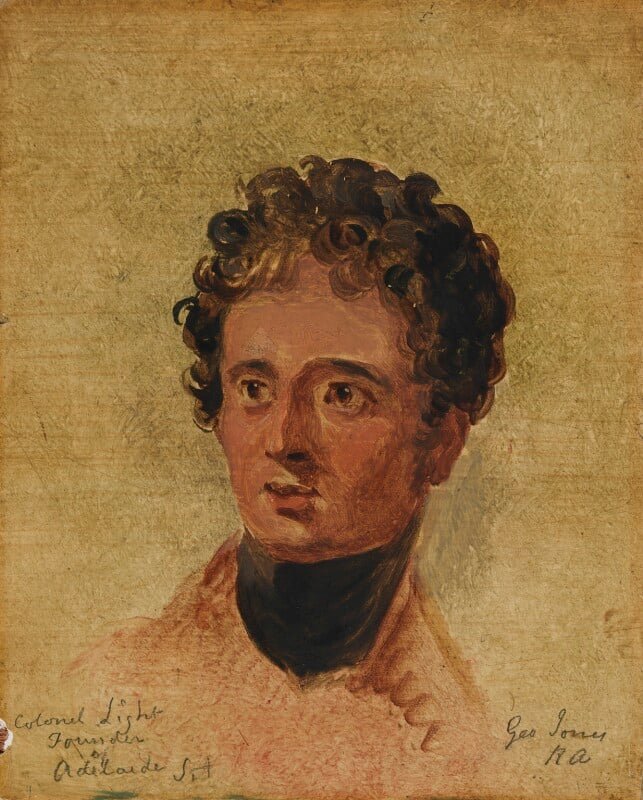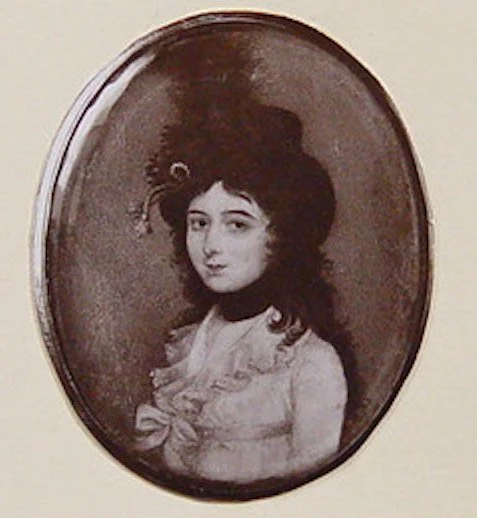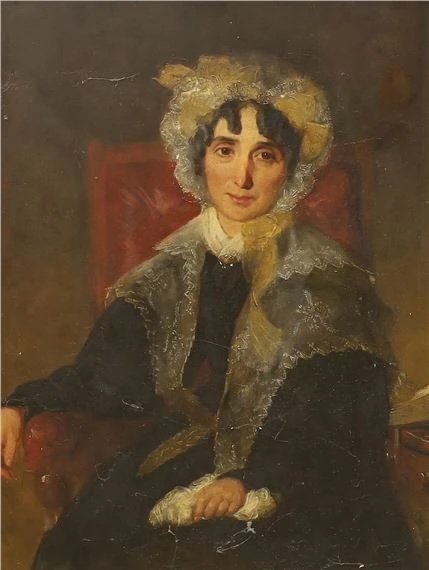Part One: Prince of Wales Island
William Light 1786-1839
self portrait c. 1815
William Light by George Jones R.A.
Legacy follows the incredible story of the life and times of William Light, born in Kedah on the Straits of Malacca a few months before the settlement of Penang by his father Francis Light in August 1786. Dispatched to Suffolk for schooling at the early age of six, William had little subsequent contact with the East or his family for many years.
With no fortune or contacts, William Light forged a career for himself first in the navy and then more famously in the army during the Peninsular War where he was attached to the staff of the Duke of Wellington himself. Despite his bravery and the many commendations he received, however, he was never promoted to senior rank, possibly as a result of his mixed heritage, which would be a major obstacle at this time.
William married twice: first to a relatively unknown Irish woman E. Pérois, who appears to have died young, and then to a famous society beauty Mary Bennet with whom he travelled Europe for several years, indulging in his passion for travel and painting. Ultimately, the marriage was ill-fated and the couple separated. In his later life Light formed a close relationship with Maria Gandy but they were unable to marry because he and Mary had never divorced.
After a period serving as an advisor to the Pasha of Egypt, Light was appointed Surveyor-General of the new state of South Australia where he famously founded and designed the beautiful city of Adelaide. William Light died in November 1839 of tuberculosis, that he had probably contracted in a Spanish prison years before.
The Light siblings
Francis Light and Martinha Rozells shared five children: Sarah, Ann, Mary, William and Francis Jnr. Details of their lives are sketchy. ‘Legacy’ recreates their stories shedding light on the plight of Eurasians in the East Indies and Europe at this period.
Sarah Light c. 1778-1839
Sarah was the eldest of the family. She was sent to school in Calcutta aged about eight years old as the ward of William Fairlie, business partner of Francis Light. In 1794, only a few weeks after the death of her father, Sarah married a young Scottish lieutenant of good family, James Gascoigne Welsh. It was to be a happy marriage and produced nine children. Sarah was an army wife who travelled the length and breadth of India with her husband as he rose through the ranks, eventually becoming a Lieutenant General. She died in 1839 at Vishakapatnam where she was buried. On her tomb her husband had inscribed: ‘Lovely to the end.’
Sarah Light Welsh miniature c. Jan 1795
Her resemblance to William is striking!
A more mature Sarah Light
Ann ‘Lukey’ Light - dates unknown
Little is known about Ann –not even the provenance of her unusual nickname– other than that she was sent to Calcutta for schooling, like her sister before her placed under the care of William Fairlie. Ann later became the companion to the widowed Mrs John Ogilvie, another family friend, whose daughter Margaret was married to Fairlie himself. As the Fairlies and Ogilvies were influential wealthy merchant families, Ann must have been introduced to fine society through them. In 1809, she married Dr Charles Hunter, Chief Surgeon of Bengal. The marriage produced two sons, Charles Morley Hunter (1812) and George Morley Hunter (1814) , both of whom died young: George in the army (1831) sadly only a few months after the death of his own father, and Charles in a tragic drowning accident aged 25 in 1837. By then Ann was quite alone in Calcutta, her surviving siblings scattered across the globe. No image exists of Ann.
William and Margaret Fairlie with their family c. 1802 by Robert Home
Mary Light 1783 -1844
A record of Mary’s baptism in Kedah has survived, pinpointing her birth to 1783, although little else in known about her childhood other than that she was always close to William with whom she regularly corresponded throughout her life. In 1790, Mary joined her sisters in Calcutta where she was to live for many years., making an excellent marriage in 1805 at the age of eighteen to a wealthy young indigo planter George Boyd, whose father was the Chief Surgeon of Bengal with Dr Charles Hunter as his assistant. The two families were probably close.
The year before their marriage, Mary and George travelled to Britain to visit relatives where Mary and William finally met up after so many years apart. Subsequently William travelled back to India for their wedding, where he probably met up with his other siblings, and possibly his mother too.
In 1836, George retired as a nabob with a substantial fortune and the family returned to Britain along with their unmarried children where they owned n a fine establishment in Kensington and a house in Edinburgh. Sadly by this time, William had left for Australia, their ships apparently passing in the Solent, unbeknownst to each other.
Mary died in 1844 in Boulogne-sur-Mer, where she may have been living for her health – which may have been another reason for their premature return from India. It is thought some of the Penang relatives visited her there before she died, possibly her half sisters, the children of Martinha and Jan Timmer.
Mary’s great grandson, Archibald Francis Steuart wrote the first biography of Francis and William Light in 1901, benefitting from the access he had to private diaries and correspondence still in the family archives. (see book cover) No authenticated picture of Mary survives although an image attributed to the famous London portrait artist John Prescott Knight (1803-81), may indeed by Mary after her return to London in 1836.
This image has been identified as Sarah Light and attributed to the portrait artist John Prescott Knight. Knight however never visited India. It is more likely that the portrait is Mary Light Boyd who was wealthy enough to afford such a work by such an eminent artist like Knight who was very productive from 1835 onwards, when Mary was newly arrived in London.
Francis ‘Lanoon’ Light (c 1790/1-1823)
Francis Light junior was born on Prince of Wales Island (Penang) and was generally known by the unusual nickname of Lanoon, a corruption of the Malay lanun ‘pirate’, which itself was derived from the notorious regional pirates the Illanun (Iranun)’. This family name may commemorate his father’s defeat of Illanun mercenaries about the time of his birth during the 1791 war with Kedah. Very little is known about Lanoon’s childhood other than that he was raised by his mother in Penang and would have been with her when she married her second husband, Hubertus Jan Timmer.
The next we hear of Lanoon concerns his involvement in the conquest of Java in 1811 under Thomas Stamford Raffles. Lanoon was subsequently appointed Resident of Minto (Muntok), the main settlement on Bangka island, at the centre of the lucrative Sumatran tin trade. Lanoon appears to have only held this position for two years from 1812-4, after which he returned home to Penang with a young wife, Charlotte Arboni, thought to be of French-Javanese heritage. Lanoon and Charlotte had three children: Sarah Martina, William Francis, and Robert Rollo. The names appear to be significant. Lanoon died on October 25 1823 in Penang. His family continued to reside there, the boys attending Penang Free School.
The Capel/ Alvisse families:
Penang descendants of Lanoon Light
Denizens of Prince of Wales Island
Hubertus Jan Timmer c. ?-1819 )
Very little is known for certain about Hubertus Jan Timmer before he arrives on the island although it has been suggested he had previously worked for a Dutch factory in Rangoon. The first veritable record is his marriage to Martinha Rozells at Government House in April 4th 1799. The marriage produced two daughters: Maria Elisabeth, born in 1800 and Jansie Anna (Joanna) 1801-3. At this period, Timmer sold Martinha’s house and the Well Estate to James Scott (or his proxies). it appears that Timmer had abandoned his family by 1804.
Timmer resurfaced in Chinsurah, a Dutch settlement 50 kilometres north of Calcutta where he formed a relationship with a woman called Eleanora Blackwell. They had four children together. It is presumed that Timmer had some business there sufficient to maintain his second family.
When he died in 1819, he left a small sum of money of 50 sicca rupees each (around 25 Spanish dollars) to his two daughters by his legal wife Martinha on the understanding that this was full payment against any claims they might have on his estate. Nothing was granted to Martinha herself.
In 1816 Maria Timmer married William Anchant, a civil servant, later school master at Penang Free School; they had a large family. In 1818 Jansie married Captain Herman Nail of the Madras Infantry, which produced a son, Peter. They were both living on Prince of Wales Island at the time of Martinha’s death in 1822 although it is likely Maria and family returned to England. She visited her half sister Mary in Boulogne.
Chinsurah on the Hooghly River, Bengal
Cauder Mohideen Merican c. 1759-1834
Born in Pondicherry, Cauder Mohideen was an Indian Muslim of Arab/Labbai descent who settled in the Straits at a young age with his mother Fatima and younger brother Mohammed Nordin. Some sources suggest they lived at the Malay village at Batu Uban, Penang pre-1786 but it is most likely they were first based in the Kuala Muda area of Kedah, crossing to the island after the British settlement. The brothers were merchant traders conducting business between Kedah, Aceh and India, mostly dealing in textiles and jewels. On Prince of Wales island, however, they prospered and by 1800 they were one of the leading Muslim merchant families who were to become known as Jawi Peranakan (local born Muslims of Malay/Indian heritage). At the time, they were called Chulias (Indians from the Coromandel Coast) or Kelings (although this name is now regarded as derogatory) and settled in the area around Lebuh Chulia, Kampong Kolam and Jalan Masjid Keling.
In 1801, Cauder (Kadir) Mohideen Merican was appointed Kapitan Keling, the official head of the Chulia community. He was responsible for the building of the beautiful Kapitan Keling mosque which still dominates the crossroad of this area today on land that was donated to the community by the British administration, demonstrating the good relations between him and the government of the island. The mosque was funded by him and from donations from the faithful.
The Kapitan Keling Mosque today (enlarged in the 1930s)
(Image: Mohammed Al-Nasar, Wikipedia 2010)
Khoh Kok Chye c. 1783-1849
The character of Khoh Kok Chye in 'Legacy’ was woven from the very sketchy outline which is all that has survived of his personal story. He was one of the sons of the first Kapitan Cina of Penang, Koh Lay Huan (Chewan), who was himself closely allied to Francis Light from the very beginning in 1786. Kok Chye was raised to be multilingual, speaking Hokkien, Malay and English fluently. He regarded himself as Peranakan (following his mother Saw It Neoh), unlike his brother Aun Peng who was sent back to China to follow a traditional mandarin education.
Kok Chye also formed part of the Penang merchant contingent who accompanied the Java expedition in 1811, along with Penang-based country ship captains like the Scotts. After this period the family diversified into tin and opium (as well as their existing investments) which became the basis for their subsequent fortune.
His eldest son, Koh Teng Choon, was English educated and married into the Khoo family (Khoo Kongsi), allying these two leading dynasties of the Chinese community. Kok Chye’s grandson was the famous Penang Peranakan millionaire philanthropist Koh Seang Tatt J.P. (1833-1908) who built Edinburgh House on what came to be known as Duke Street, when he hosted Prince Alfred, the Duke of Edinburgh, in 1869. The house was demolished c. 1970 when the Dewan Sri Pinang concert hall was built.
A Chinese Peranakan family of Penang. Image Credit: OleSayang.com
Koh Seang Tatt and his wife Oon Geok Teah Image Credit: Singapore Peranakan Museum
Edinburgh House c. 1870
Image Credit: Penang State Art Gallery













